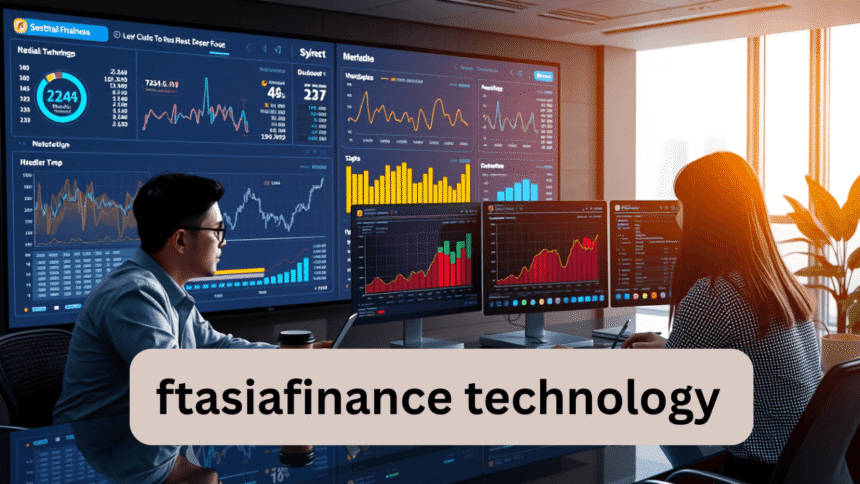The fintech industry across Southeast Asia has experienced an incredible transformation in recent years. Much of this progress is driven by powerful platforms like ftasiafinance technology, which are redefining how financial services operate and grow in emerging markets. With millions of unbanked individuals, evolving regulations, and a high rate of mobile penetration, Southeast Asia has become a prime region for fintech expansion—led strongly by innovation and strategic implementation.
From digital payments to AI-powered financial tools, ftasiafinance technology is making financial access smoother, smarter, and more inclusive. In this blog, we will explore how this technology is shaping the region, its core strengths, and the opportunities it creates for startups, investors, and users alike. Whether you’re a curious learner or a fintech entrepreneur, understanding the power and impact of ftasiafinance technology is essential today.
How ftasiafinance Technology is Transforming Southeast Asia’s Fintech Sector

Southeast Asia is one of the fastest-growing fintech markets globally, and the presence of platforms like ftasiafinance technology has amplified that growth. The unique combination of mobile-first populations, growing middle classes, and increasing digital literacy makes the region fertile ground for financial innovation. But what exactly is driving this wave?
The Rise of Fintech in Southeast Asia
More than 70% of Southeast Asians are either underbanked or unbanked, which presents a massive opportunity. Fintech players are solving these challenges with mobile wallets, lending platforms, and insurance tech. ftasiafinance technology plays a critical role by offering scalable, secure, and adaptable solutions for startups and banks looking to enter this digital space.
Key Drivers Behind Fintech Adoption
There are several reasons why fintech adoption is booming in Southeast Asia:
- Smartphone Penetration: Affordable smartphones are bringing banking services to rural areas.
- Internet Growth: Improved infrastructure is connecting more people online.
- Government Support: Regulatory sandboxes in countries like Singapore and Indonesia foster innovation.
- Young Demographics: Tech-savvy millennials are open to digital banking and investments.
These drivers work in tandem with ftasiafinance technology, which provides the digital backbone for modern financial services.
Core Innovations Powered by ftasiafinance Technology
1. Digital Payments Revolution
With platforms like GrabPay, ShopeePay, and GCash becoming household names, digital payments are at the forefront of fintech evolution. ftasiafinance technology supports payment gateway integration, security protocols, and seamless UX/UI features. This allows businesses to offer fast, secure, and scalable payment solutions across borders.
2. AI and Machine Learning in Financial Services
AI is another area where ftasiafinance technology excels. Machine learning tools analyze transaction patterns, detect fraud, and personalize customer experiences. Banks and neobanks use AI-powered chatbots to reduce service costs while improving response times.
3. Blockchain and Digital Identity
Blockchain is not just about crypto anymore. It enables secure transactions, smart contracts, and cross-border payments. This technology includes modules that support decentralized finance (DeFi) applications, helping users access financial services without intermediaries.
Opportunities for Fintech Startups Using ftasiafinance Technology

Startups across Vietnam, Thailand, and the Philippines are launching fintech products that cater to local needs. This technology provides the infrastructure that helps them scale quickly without building everything from scratch.
Benefits for Startups
- Speed to Market: Plug-and-play APIs reduce development time.
- Security Compliance: Built-in tools ensure startups meet regional laws like PDPA or GDPR.
- Customizable Modules: Tailored services for digital lending, wallets, or investment platforms.
Here’s a quick table showing how startups in different countries are using ftasiafinance technology:
| Country | Popular Fintech Model | Use of ftasiafinance Technology |
|---|---|---|
| Indonesia | Peer-to-Peer Lending | Risk analysis, user verification modules |
| Philippines | Mobile Wallets | Wallet SDK, KYC onboarding |
| Vietnam | Online Investment Platforms | Portfolio analytics, real-time dashboards |
| Thailand | BNPL (Buy Now, Pay Later) | Credit scoring, transaction tracking |
Challenges and How ftasiafinance Technology Addresses Them
Despite growth, fintech in Southeast Asia faces several roadblocks. Here’s how this technology helps overcome them.
1. Regulatory Differences
Each country has its own financial regulations. The platform includes multi-country compliance settings to help fintech firms navigate legal complexities without delays.
2. Cybersecurity Threats
Security is a top concern. This technology features multi-factor authentication, data encryption, and fraud detection systems to ensure safe transactions.
3. Infrastructure Limitations
Some rural areas still suffer from poor connectivity. The technology is optimized for low-bandwidth environments to offer uninterrupted service.
Future of Fintech
Cross-Border Financial Integration
As ASEAN pushes for financial integration, platforms like ftasiafinance technology are well-positioned to enable seamless transactions across markets. Real-time remittance, multi-currency wallets, and international lending will soon become the norm.
Green and Sustainable Finance
There’s rising interest in eco-conscious investments. ftasiafinance technology is working on ESG-friendly investment models to help users make ethical financial decisions.
FAQs
Q1: What is ftasiafinance technology primarily used for?
A: It’s a fintech platform designed to power digital payments, lending, AI-based financial tools, and blockchain-based services across Asia.
Q2: Can small startups use ftasiafinance technology?
A: Yes. It’s built to support both early-stage startups and large financial institutions with modular and scalable services.
Q3: Is ftasiafinance technology secure and compliant with regulations?
A: Absolutely. It features end-to-end encryption, KYC compliance, and aligns with local and international regulations.
Q4: How is ftasiafinance technology different from traditional financial software?
A: It’s cloud-based, API-driven, and integrates AI and blockchain—making it more agile and adaptable than older legacy systems.
Conclusion
Southeast Asia stands at the edge of a digital finance revolution. As mobile usage surges and financial access widens, the region will continue to witness rapid innovation. Platforms like ftasiafinance technology are leading this transformation by offering flexible, smart, and secure solutions for every stakeholder—startups, banks, and end-users alike.
If you’re part of the fintech ecosystem, now is the perfect time to explore how this technology can elevate your offering and future-proof your services. The wave of innovation is here—are you ready to ride it?
Also read: Wheon.com Business Ideas

